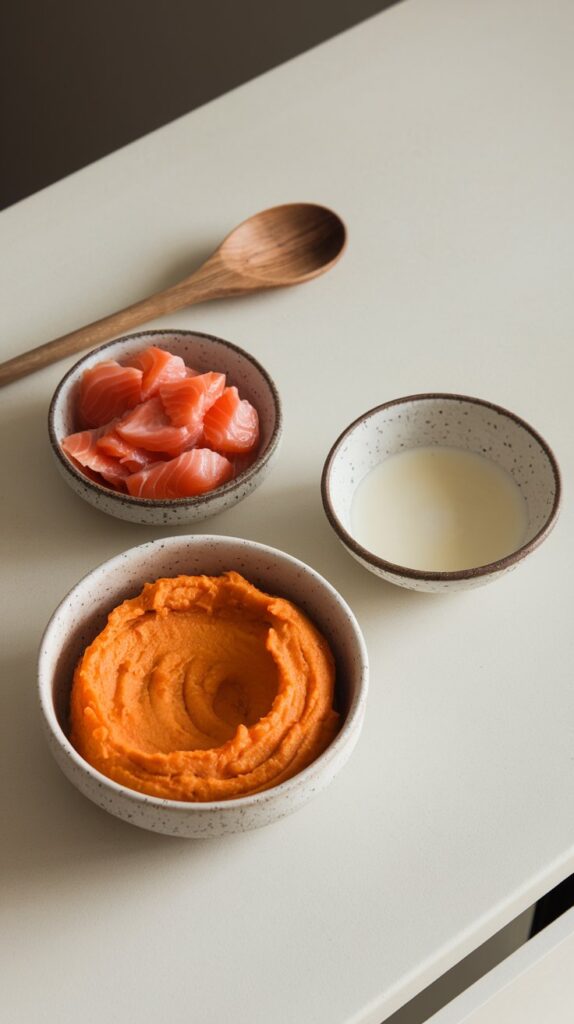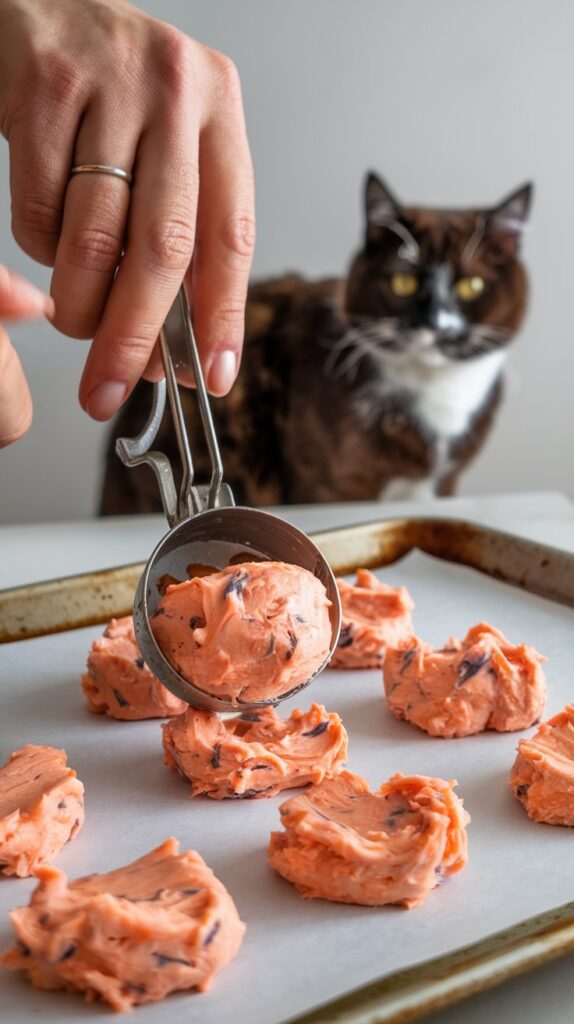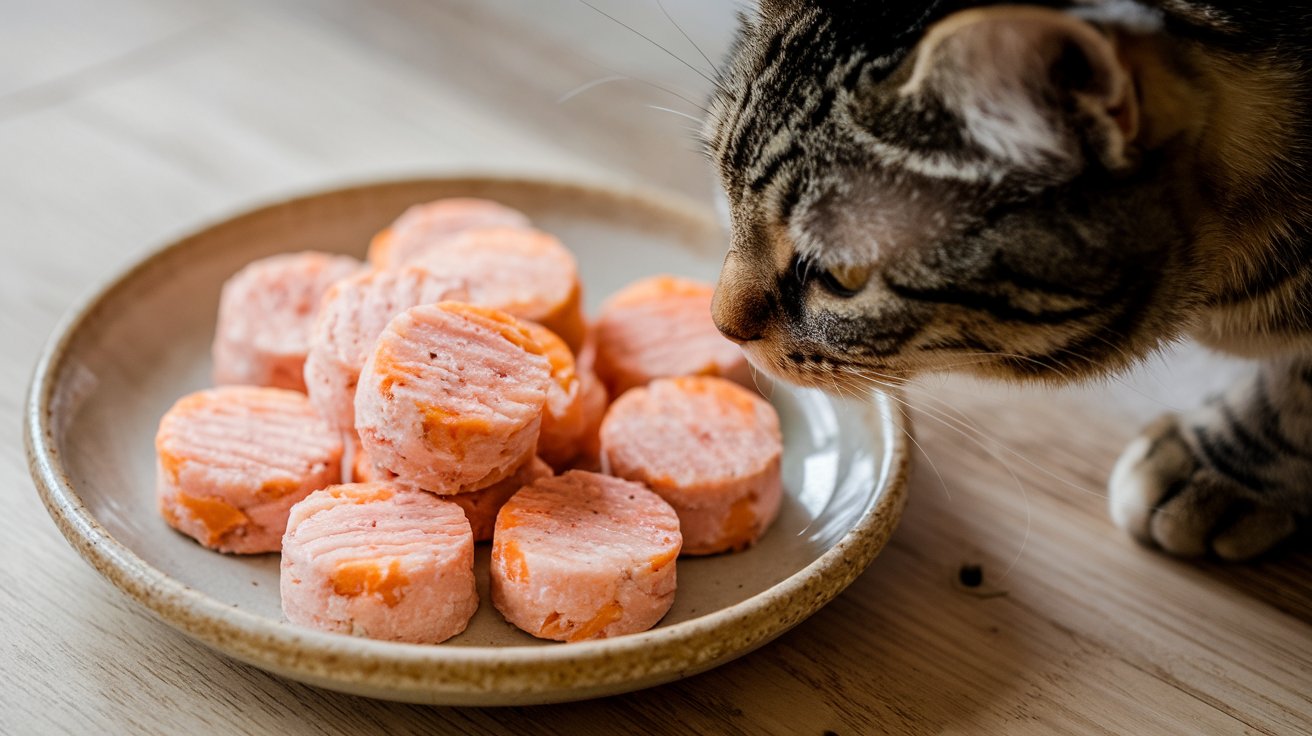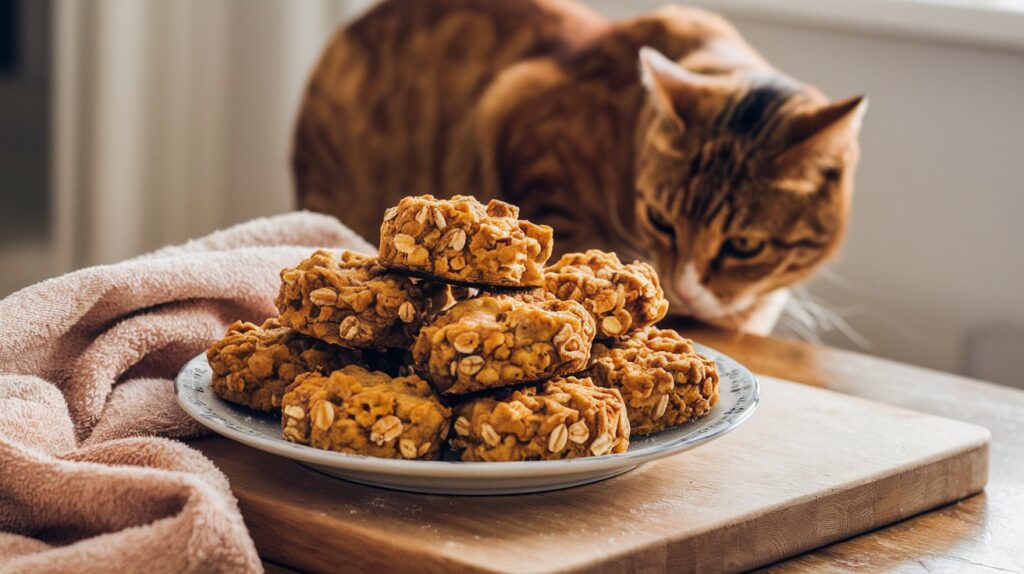Making Coconut Oil and Salmon Soft Cat Chews at Home
Creating your own cat treats is a rewarding way to ensure your feline friend enjoys fresh, natural ingredients that promote a healthy coat and overall well-being. Our Coconut Oil & Salmon Soft Chews are part of three easy, natural recipes we’ve shared, and in this post, we’re diving deeper into this particular nutrient-packed treat.
Let’s explore how it supports your cat’s health and how you can make it at home.
Boost Your Cat’s Health with Natural Ingredients
When it comes to your cat’s diet, quality matters. By choosing natural, whole-food ingredients, you’re not only avoiding unnecessary additives but also providing essential nutrients that can make a real difference in your cat’s vitality. This recipe combines the benefits of:
- Salmon: Rich in omega-3 fatty acids, salmon supports skin health and gives your cat’s coat a glossy shine. Its high protein content also contributes to muscle strength and overall energy.
- Coconut Oil: Known for its moisturizing properties, coconut oil helps maintain healthy skin while also aiding digestion. Its natural fats can be a great energy source for your active feline.
- Sweet Potato: A powerhouse of vitamins and fiber, sweet potato helps regulate digestion and provides a gentle energy boost, making it an ideal ingredient in a balanced treat.
Why Choose Homemade Cat Treats?
Store-bought treats often contain preservatives and additives that can sometimes do more harm than good. By making treats at home, you have full control over what your cat eats. This recipe is straightforward and quick to prepare, ensuring that you always have a batch of healthy, homemade treats ready for when your cat deserves a little extra love.
Key Ingredients and Their Nutritional Highlights
Your cat treats start with a few simple, high-quality ingredients that deliver a wealth of nutrition in every bite. Let’s break down what each component brings to your feline friend’s health:

Salmon: A Powerhouse of Omega-3s and Protein
Using 1/4 cup of cooked, flaked salmon, this recipe harnesses the benefits of:
- Omega-3 Fatty Acids: These essential fats are renowned for promoting a shiny, healthy coat and supporting skin integrity.
- High-Quality Protein: Salmon provides the protein needed for muscle development and overall vitality.
- Natural Nutrient Boost: When prepared without added salts or seasonings, salmon delivers pure, natural nutrition to support your cat’s energy levels and overall health.
Coconut Oil: Natural Moisturizer and Digestive Aid
Incorporating 1 tablespoon of coconut oil adds more than just a subtle flavor:
- Enhanced Skin & Coat Health: The moisturizing properties of coconut oil help maintain a soft, lustrous coat, while its fatty acids keep the skin supple.
- Digestive Support: Coconut oil aids in digestion and nutrient absorption, providing a smooth digestive experience for your cat.
- Natural Energy Source: As a natural fat, coconut oil offers a gentle energy boost that’s especially beneficial for active felines.
Sweet Potato: A Source of Vitamins and Fiber
Adding 1/4 cup of mashed sweet potato not only binds the ingredients together but also offers a smooth texture. Simply steam or bake it until soft, then mash with a fork:
- Vitamins A and C: These vitamins are critical for immune support and overall cellular health, ensuring your cat stays robust and active.
- Dietary Fiber: The fiber content promotes healthy digestion and regular bowel movements, making it easier for your cat to process the treat.
- Natural Sweetness and Texture: Its smooth consistency creates a cohesive blend, enhancing the texture of the treats without overpowering the natural flavors.
Tip: Feel free to make a larger batch by increasing all ingredients proportionally.
Essential Kitchen Tools for Homemade Cat Treats
Having the right kitchen tools can make all the difference when preparing these nutritious, homemade treats. With just a few essential items, you’ll be well-equipped to mix, form, and bake your Coconut Oil & Salmon Soft Chews to perfection.
1. Mixing Bowl and Spoon
A sturdy mixing bowl and a reliable spoon or spatula are crucial for combining the flaked salmon, coconut oil, and mashed sweet potato evenly. This ensures every treat is packed with the perfect balance of nutrients and flavors.
2. Parchment-Lined Baking Sheet
A baking sheet lined with parchment paper prevents the treats from sticking and allows for even baking. It also makes cleanup a breeze, so you can spend more time enjoying your pet’s delightful reactions to their new treats.
3. Measuring Cups and Spoons
Precision is key in any recipe. Using accurate measuring tools guarantees that you’re incorporating exactly 1/4 cup of cooked salmon, 1 tablespoon of coconut oil, and 1/4 cup of mashed sweet potato into each batch. This helps maintain the consistent texture and nutritional benefits of your treats.
4. Oven or Toaster Oven
A reliable oven preheated to 350°F (175°C) is essential for baking the treats to just the right texture. Whether you use a traditional oven or a toaster oven, consistent heat ensures the chews turn out firm enough to hold their shape while remaining soft and chewable for your cat.
Step-by-Step Guide to Making Coconut Oil & Salmon Soft Chews
Creating these homemade cat treats is a straightforward process that transforms a few natural ingredients into a delightful, nutrient-packed snack for your feline friend. Follow these detailed steps to ensure every treat is perfectly balanced in texture and flavor:
1. Preheat Your Oven
Begin by setting your oven to 350°F (175°C). Preheating is crucial for ensuring the treats bake evenly and achieve the ideal soft yet firm texture.
2. Mix the Ingredients Thoroughly
In a medium-sized mixing bowl, combine the cooked salmon, coconut oil, and mashed sweet potato. Use a spoon or spatula to mix until the ingredients are evenly incorporated. This step is essential to ensuring each treat has the perfect balance of flavor and nutritional benefits.
3. Shape into Bite-Sized Treats
Once your mixture is well combined, form it into small, bite-sized balls or slightly flattened chews—ideal for your cat to enjoy. Arrange these treats on a parchment-lined baking sheet, leaving a little space between each one for even baking.

4. Bake to Perfection
Place your baking sheet in the preheated oven and bake for 10-12 minutes. Keep an eye on the treats as oven temperatures can vary. You’re aiming for treats that are just firm enough to hold their shape while remaining soft and easy to chew.
5. Cool Completely Before Serving
Remove the treats from the oven and let them cool completely on a wire rack. Cooling is essential not only for safety but also to allow the treats to set, ensuring they maintain the desired texture when served.
Proven Tips for Softer Chews and Flavor Variations
Enhance your homemade treats with these simple tweaks to achieve the perfect texture and add exciting variations to your cat’s snack routine:
- Adjust Baking Time for Desired Texture: For chews that are extra soft, consider reducing the baking time by a couple of minutes. Keep an eye on them to ensure they maintain a tender texture that’s gentle on your cat’s teeth.
- Experiment with Protein Options: While our recipe features salmon, you can occasionally substitute it with cooked chicken or tuna. Each protein offers its unique flavor profile and nutritional benefits, keeping treat time interesting for your feline friend.
- Incorporate Cat-Friendly Herbs: A light sprinkle of dried catnip or a dash of ground flaxseed can add an enticing aroma and extra nutrients to your treats. These ingredients are safe for cats and may support digestion and a healthy coat, especially for picky eaters.
Safe Storage and Serving Suggestions
Proper storage and serving practices are just as important as preparing the treats. Here are some guidelines to keep your treats fresh and ensure they’re served safely:
- Refrigeration for Short-Term Freshness: Store your treats in an airtight container in the refrigerator for up to one week. This method helps maintain the nutritional value and texture of the chews.
- Freezing for Extended Storage: If you’re preparing a large batch, consider freezing the treats. Place them in freezer-safe bags or containers and thaw a few at a time when needed, keeping them fresh for up to one month.
- Moderation is Key: Remember that these treats are a supplement to your cat’s regular diet. Serve them in moderation to avoid overfeeding and to ensure they remain a special reward for your pet.
Frequently Asked Questions About Homemade Cat Treats
1. Can I use canned salmon instead of cooked, flaked salmon?
Yes! If you opt for canned salmon, be sure to choose one packed in water without added salt. Drain it well and flake it into small pieces before mixing.
2. Are these treats suitable for kittens or senior cats?
Absolutely. For kittens or senior cats who might need a softer texture, you can reduce the baking time slightly to ensure the treats remain tender and easy to chew.
3. How frequently should I offer these homemade treats?
These treats are designed as a supplement to your cat’s regular diet. Serving them in moderation—about a few treats a week—helps maintain a balanced diet without overfeeding.
Treat Your Cat to Coconut Oil and Salmon Soft Cat Chews
Homemade treats are a wonderful way to ensure your cat enjoys healthy, natural ingredients while adding a personal touch to their diet. With our easy-to-follow recipe and tips, you can create soft, delicious chews that not only taste great but also support your pet’s well-being.
For more cat and dog recipes, DIY fun stuff, and health tips, remember that Sweet Purrfections is your go-to blog for all things pet-related. Happy baking, and here’s to your furry friend’s health and happiness!
Meet Sean, a fintech whiz with a penchant for pet purrs and blockchain buzz. After a decade of fintech feats, Sean’s tech talents leaped from ledger lines to litter lines, driven by a passion for pets and a vision for a more connected pet care community. With three critter companions as co-pilots, Sean launched this blog to share a treasury of pet-friendly tech tips and tales.



